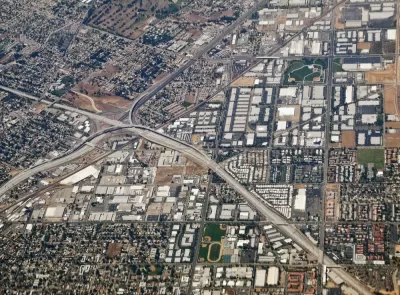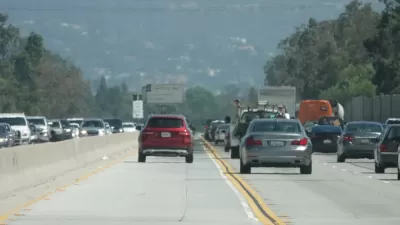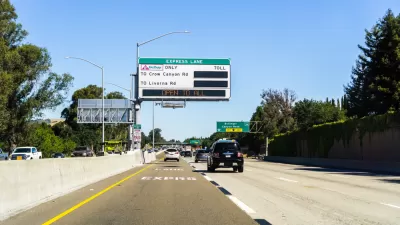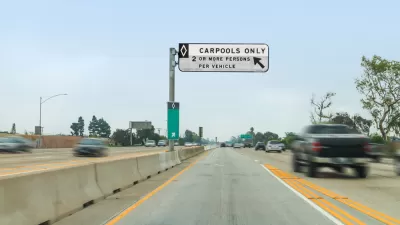No one's suggesting that freeways will be converted to tollways, but a pattern is emerging that when freeways are widened, express lanes, financed in part by user fees, are being added rather than mixed-flow lanes. Case in point: the Inland Empire.

The March opening of the new 91 express lanes in Southern California's Inland Empire is the basis for a broader piece by Imran Ghori, politics reporter for the Press-Enterprise, on future toll lanes coming to the region, a pattern extends beyond California, for two good reasons.
Their growth in the Inland area reflects a regional and national trend in which transportation agencies are turning to toll lanes to finance freeway improvements and manage congestion. The lanes are easier to build because they’re paid for by tolls.
“The idea is catching on quickly and spreading throughout the country,” said Martin Wachs, a professor emeritus of urban planning at the UCLA Luskin School of Public Affairs and an expert on transportation policy and planning.
Congestion management through pricing
[C]harging a toll allows the agencies to manage congestion, while general lanes only provide short-term relief and quickly fill up as they are built, he said. Traffic studies have shown that motorists will readjust their driving patterns and more will drive during peak times when free lanes are added, Wachs said.
“The only way to ensure that traffic is moving more swiftly is to charge people for it,” he said. “It can always reduce congestion because you can raise the price higher and higher until some people choose not to use it.”
Financing through loans paid by user fees
"State and federal transportation dollars are scarcer for projects that don’t do more to manage congestion through carpool or toll lanes," said John Standiford, deputy executive director of the Riverside County Transportation Commission, the agency that built and manages the aforementioned 91 Express Lanes in Riverside County.
I-15 Express Lanes
On July 20, the commission received approval of a critical $152 million Transportation Infrastructure Finance and Innovation Act (TIFIA) loan from the U.S. Department of Transportation for their next project, the 14.6-mile I-15 Express Lanes from the Temescal Valley, south of Corona, north to Jurupa Valley. The $455 million project adds two express lanes in each direction [see fact sheet (pdf)].
"This major award will help offset the local taxpayers’ share of the project cost and means RCTC and its contractor can get to work in 2018 on the I-15 Express Lanes," according to the commission. "The lanes are expected to open in mid-2020."
But this is a loan, not a grant. According to the project's FAQ [pdf]:
How will the toll revenue be used? Toll revenues will be used to operate and maintain the express lanes, repay a portion of the construction costs and pay back the bonds used to finance the project. Any additional revenue will be used for future transportation improvements including freeway, interchanges, and transit enhancements within the I-15 corridor.
Readers may recall that a $629 million TIFIA loan, secured on July 29 by the Orange County Transportation Authority, enabled the San Diego Freeway (I-405) Express Lanes in Orange County to go forward, while sales tax funding will pay for the addition of general purpose lanes.
Why not a public-private partnership?
On the East Coast, Virginia is financing their express lanes differently. Instead of TIFIA loans, they are relying on a public-private partnership to build and operate the 395 Express Lane project. Unlike the Riverside County projects, public transit will be a beneficiary of toll revenues in the agreement negotiated by the Virginia Department of Transportation's Office of Public-Private Partnerships.
San Bernardino County
Finally, Ghori reports on the first toll lanes coming to San Bernardino County – a 33-mile corridor on the 10 Freeway, planned by the San Bernardino County Transportation Authority:
The $1.8-billion project would add two toll lanes from the Los Angeles County line near Montclair east to Redlands. An auxiliary lane for traffic to weave in and out at ramps also will be added at various points along the general-purpose lanes.
Ghori reminds us that while express lanes are effective at reducing congestion and facilitating financing, politically they can be a hard sell.
The decision to use toll lanes has been controversial with some residents and members of the governing board. The board — made up of elected officials from the county and its cities — voted 16 to 2 Wednesday, July 12, to approve an environmental report and to create the toll lanes.
The authority is engaged in two other freeway projects, neither of which involve express lanes, proving that the eral of the "free" freeway will be with us for the foreseeable future.
Hat tip to Steve Birdlebough.
FULL STORY: s Inland toll lanes boom, why are new freeway lanes rarely free?

Maui's Vacation Rental Debate Turns Ugly
Verbal attacks, misinformation campaigns and fistfights plague a high-stakes debate to convert thousands of vacation rentals into long-term housing.

Planetizen Federal Action Tracker
A weekly monitor of how Trump’s orders and actions are impacting planners and planning in America.

In Urban Planning, AI Prompting Could be the New Design Thinking
Creativity has long been key to great urban design. What if we see AI as our new creative partner?

King County Supportive Housing Program Offers Hope for Unhoused Residents
The county is taking a ‘Housing First’ approach that prioritizes getting people into housing, then offering wraparound supportive services.

Researchers Use AI to Get Clearer Picture of US Housing
Analysts are using artificial intelligence to supercharge their research by allowing them to comb through data faster. Though these AI tools can be error prone, they save time and housing researchers are optimistic about the future.

Making Shared Micromobility More Inclusive
Cities and shared mobility system operators can do more to include people with disabilities in planning and operations, per a new report.
Urban Design for Planners 1: Software Tools
This six-course series explores essential urban design concepts using open source software and equips planners with the tools they need to participate fully in the urban design process.
Planning for Universal Design
Learn the tools for implementing Universal Design in planning regulations.
planning NEXT
Appalachian Highlands Housing Partners
Mpact (founded as Rail~Volution)
City of Camden Redevelopment Agency
City of Astoria
City of Portland
City of Laramie





























